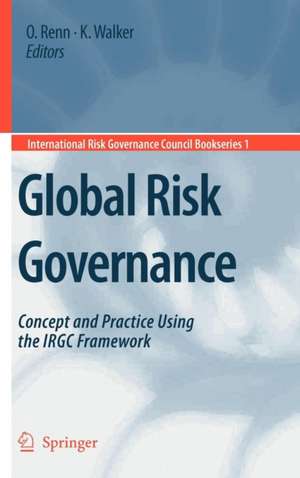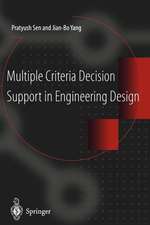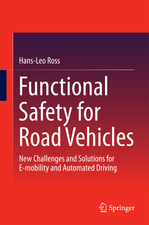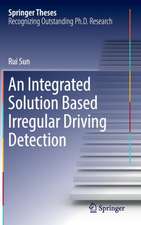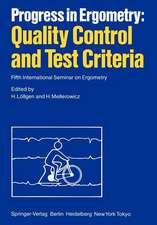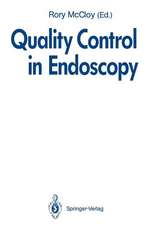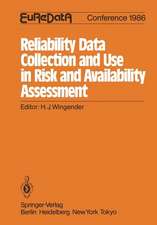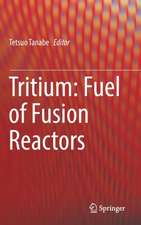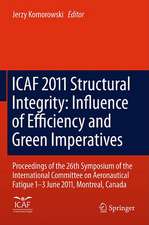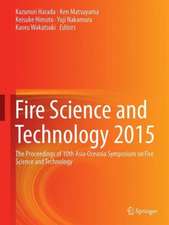Global Risk Governance: Concept and Practice Using the IRGC Framework: International Risk Governance Council Bookseries, cartea 1
Editat de Ortwin Renn, Katherine D. Walkeren Limba Engleză Hardback – 5 noi 2007
| Toate formatele și edițiile | Preț | Express |
|---|---|---|
| Paperback (1) | 949.42 lei 43-57 zile | |
| SPRINGER NETHERLANDS – 23 noi 2010 | 949.42 lei 43-57 zile | |
| Hardback (1) | 957.62 lei 43-57 zile | |
| SPRINGER NETHERLANDS – 5 noi 2007 | 957.62 lei 43-57 zile |
Preț: 957.62 lei
Preț vechi: 1167.83 lei
-18% Nou
Puncte Express: 1436
Preț estimativ în valută:
183.24€ • 191.83$ • 151.62£
183.24€ • 191.83$ • 151.62£
Carte tipărită la comandă
Livrare economică 07-21 aprilie
Preluare comenzi: 021 569.72.76
Specificații
ISBN-13: 9781402067983
ISBN-10: 1402067984
Pagini: 400
Ilustrații: XXX, 370 p.
Dimensiuni: 155 x 235 x 30 mm
Greutate: 0.79 kg
Ediția:2008
Editura: SPRINGER NETHERLANDS
Colecția Springer
Seria International Risk Governance Council Bookseries
Locul publicării:Dordrecht, Netherlands
ISBN-10: 1402067984
Pagini: 400
Ilustrații: XXX, 370 p.
Dimensiuni: 155 x 235 x 30 mm
Greutate: 0.79 kg
Ediția:2008
Editura: SPRINGER NETHERLANDS
Colecția Springer
Seria International Risk Governance Council Bookseries
Locul publicării:Dordrecht, Netherlands
Public țintă
ResearchCuprins
A Framework For Risk Governance.- White Paper on Risk Governance: Toward an Integrative Framework.- A Framework For Risk Governance: Critical Reviews.- A Framework for Risk Governance Revisited.- Enterprise Risk Management Perspectives on Risk Governance.- Comments on the IRGC Framework for Risk Governance.- White, Black, and Gray: Critical Dialogue with the International Risk Governance Council's Framework for Risk Governance.- Synopsis of Critical Comments on the IRGC Risk Governance Framework.- A Framework For Risk Governance: Case Study Applications.- Risk Governance of Genetically Modified Crops – European and American Perspectives.- Nature-Based Tourism.- Listeria in Raw Milk Soft Cheese: A Case Study of Risk Governance in the United States Using the IRGC Framework.- Nagara River Estuary Barrage Conflict.- Acrylamide Risk Governance in Germany.- Energy Security for the Baltic Region.- Nanotechnology Risk Governance.- A Framework For Risk Governance: Lessons Learned.- Lessons Learned: A Re-Assessment of the IRGC Framework on Risk Governance.
Recenzii
The International Risk Governance Council (IRGC) is an independent organization whose purpose is to help the understanding and management of emerging global risks that have impacts on human health and safety, the environment, the economy and society at large. IRGC focuses on emerging, systemic risks for which governance deficits exist and aims to provide recommendations for how policy makers can correct them. The IRGC takes a broad, interdisciplinary approach; it draws specialists from practice and academe, and from natural sciences as well as social sciences. In Global Risk Governance: Concept and Practice Using the IRGC Framework, Ortwin Renn presents a risk management framework that aims to provide a comprehensive and transparent approach to managing physical risks with global or ubiquitous consequences. This framework is the result of extensive international consultation with risk managers and the academic community. The framework has four stages beginning with pre-assessment where stakeholders and experts help decision makers frame risks. Here, managers increase institutional activity in risk by, for example, establishing agreed standards and early warning systems that identify questionable deviations from the norm. The second step is risk appraisal, which includes two phases: first, scientists estimate the consequences of a potential threat, and second, social scientists consider civil society’s understanding of the risk. The third stage is tolerability and acceptability judgement where managers weigh the empirical evidence against different social values and perceptions. The final step is risk management. Typically, this step requires significant stakeholder involvement. The book notes that by including the public in the process, managers can increase transparency in decision-making and distribute the responsibility for risk reduction between governments and society. When risk managers are unable to reach a consensus, constant communication andtransparent monitoring can often help stakeholders agree on provisional solutions. Given the nature of risk governance, the IRGC’s framework is a recurring process as depicted in the accompanying figure. Renn suggests that one of the most important risk policy issues is the treatment of different actors’ risk perceptions. Availability and assessment biases, over- and under-estimation of risks, and risks spread over time (even over generations) challenge the traditional, straightforward risk calculations and projections. Renn argues for better integration of lay views with those of experts. On the balance, he favours the latter; however, both have to be considered in order to generate stable risk-management solutions and a lasting sense of security. The framework also includes clear definitions of key terms, including the distinction of different types of risks. The framework distinguishes, for instance, between risks that are highly complex; uncertain; or ambiguous. Complex risks are those which are difficult to quantify, largely because of the multitude of potential causal agents at work. Uncertain risks refer to a state of knowledge in which the likelihood of any adverse effect or the effects themselves cannot be described precisely even though the factors influencing the issues are identified. Ambiguous risks—perhaps the most contentious aspect of the book—give rise to several meaningful and legitimate interpretations of accepted risk assessment results. Managers can rely on expert judgement when society agrees on the values underpinning a decision and the tolerability of the risk. When risk is considered complex, managers need an accepted method by which to compare available evidence. When risks are judged to be uncertain, Renn advocates a precautionary approach. When a risk is ambiguous, he suggests that a broad societal discourse will help overcome differences in values and perceptions. The book has limitations. First, it is relatively new. Whileseveral chapters include very interesting case studies from around the world, the authors of these chapters in most instances have applied the framework in an after-the-fact approach. It will be important to see the impact that the framework will have when it is applied in a detailed and systematic way to new and emerging risks. This will take time. Second, its somewhat academic tone and style make it a little less accessible to a broader audience. Third and perhaps most importantly, the framework’s strength can also be its weakness. While consultation is an important part of the process in a democratic society seeking stable risk management solutions, as Löfstedt and van Asselt as well as North note in their respective chapters, it is often difficult to build consensus, and therefore consultation can also be expensive and time consuming. Indeed, conducting the appropriate amount of consultation might be a bit more art than science. This is a significant challenge for most risk management processes; again, more time and research will suggest the extent to which the framework can accommodate multiple and competing views, and do so in an acceptably efficient manner. For more information on the International Risk Governance Council’s research on this and other policy files, please visit their website, www.irgc.org. Notably, the IRGC has recently published Managing and Reducing Social Vulnerabilities from Coupled Critical Infrastructures, a copy of which is available on their website.
Craig O’Blenis is a recent graduate of Dalhousie University’s Masters of Public Administration program. For more information on this article, please contact him at craig.oblenis@gmail.com
Craig O’Blenis is a recent graduate of Dalhousie University’s Masters of Public Administration program. For more information on this article, please contact him at craig.oblenis@gmail.com
Textul de pe ultima copertă
Global risks, global opportunities, global risk governance challenges.
Global risks are not confined to national borders; they cannot be managed through the actions of a single sector. The governance of global, systemic risks requires an integrative approach involving governments, intergovernmental organizations, industry, academia and civil society.
Risk accompanies change. It is a permanent and important part of life and the willingness and capacity to take and accept risk is crucial for achieving economic development and introducing new technologies. Many risks, and in particular those arising from emerging technologies, are accompanied by potential benefits and opportunities. The challenge of better risk governance lies here: to enable societies to benefit from change while minimizing the negative consequences of the associated risks.
The International Risk Governance Council (IRGC) is an independent organisation whose purpose is to help the understanding and management of emerging global risks that have impacts on human health and safety, the environment, the economy and society at large. IRGC’s work includes developing concepts of risk governance, anticipating major risk issues and providing risk governance policy recommendations for key decision makers. IRGC believes that improvements in risk governance are essential if optimal risk-related decisions are to be made and to maximise trust in the processes and structures by which they are made.
This book, Global Risk Governance: Concept and Practice Using the IRGC Framework, presents IRGC’s innovative risk governance framework, the careful reviews it received from internationally recognized scientists, and the results of several case studies in which the framework has been applied to a number of significant but different risks. The IRGC’s framework provides a structure for how particular risks may be investigated, communicated andmanaged by taking into account not only scientific evidence but also risk perceptions, social concerns and societal values. It seeks to provide a comprehensive and integrated view of risk governance and, so, assist decision makers with asking the right questions and developing more effective risk governance strategies for the increasingly complex opportunities and risks we face in the world.
"The IRGC framework represents a new and important contribution to the broad body of work on risk management and sheds light on the kind of risk framework necessary to address 21st century global risk issues. It challenges the sustainability and scalability of generally accepted approaches adopted by the commercial sector. I look forward to road-testing some of IRGC’s concepts within my company!"
Peter Sutherland
Head of Group Risk & Compliance
Insurance Australia Group, Sydney, Australia
"There is little question that the integrated framework developed (by IRGC) will prove to be effective guidance for risk policymakers and managers at all levels of society and government. It will inform risk policy and practice."
Eugene A. Rosa
Edward R. Meyer Professor of Natural Resource and Environmental Policy
Washington State University
Global risks are not confined to national borders; they cannot be managed through the actions of a single sector. The governance of global, systemic risks requires an integrative approach involving governments, intergovernmental organizations, industry, academia and civil society.
Risk accompanies change. It is a permanent and important part of life and the willingness and capacity to take and accept risk is crucial for achieving economic development and introducing new technologies. Many risks, and in particular those arising from emerging technologies, are accompanied by potential benefits and opportunities. The challenge of better risk governance lies here: to enable societies to benefit from change while minimizing the negative consequences of the associated risks.
The International Risk Governance Council (IRGC) is an independent organisation whose purpose is to help the understanding and management of emerging global risks that have impacts on human health and safety, the environment, the economy and society at large. IRGC’s work includes developing concepts of risk governance, anticipating major risk issues and providing risk governance policy recommendations for key decision makers. IRGC believes that improvements in risk governance are essential if optimal risk-related decisions are to be made and to maximise trust in the processes and structures by which they are made.
This book, Global Risk Governance: Concept and Practice Using the IRGC Framework, presents IRGC’s innovative risk governance framework, the careful reviews it received from internationally recognized scientists, and the results of several case studies in which the framework has been applied to a number of significant but different risks. The IRGC’s framework provides a structure for how particular risks may be investigated, communicated andmanaged by taking into account not only scientific evidence but also risk perceptions, social concerns and societal values. It seeks to provide a comprehensive and integrated view of risk governance and, so, assist decision makers with asking the right questions and developing more effective risk governance strategies for the increasingly complex opportunities and risks we face in the world.
"The IRGC framework represents a new and important contribution to the broad body of work on risk management and sheds light on the kind of risk framework necessary to address 21st century global risk issues. It challenges the sustainability and scalability of generally accepted approaches adopted by the commercial sector. I look forward to road-testing some of IRGC’s concepts within my company!"
Peter Sutherland
Head of Group Risk & Compliance
Insurance Australia Group, Sydney, Australia
"There is little question that the integrated framework developed (by IRGC) will prove to be effective guidance for risk policymakers and managers at all levels of society and government. It will inform risk policy and practice."
Eugene A. Rosa
Edward R. Meyer Professor of Natural Resource and Environmental Policy
Washington State University
Caracteristici
Timely topic, first volume in a new series
